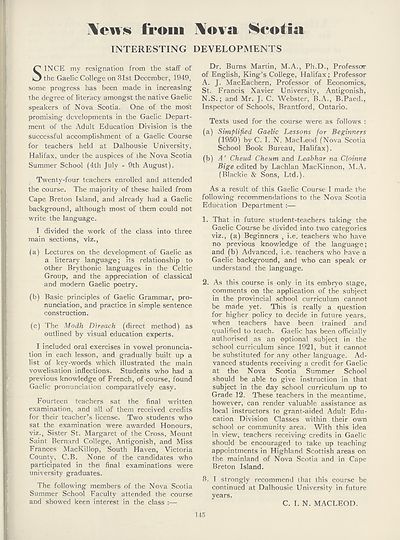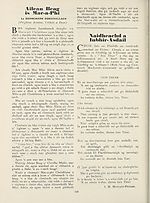An Comunn Gàidhealach Publications > Gaidheal > Volumes 44--45, January 1949--December 1950
(511) Page 145
Download files
Complete book:
Individual page:
Thumbnail gallery: Grid view | List view

Xews from \»%a Nrotia
INTERESTING DEVELOPMENTS
SINCE my resignation from the staff of
the Gaelic College on 31st December, 1949,
some progress has been made in increasing
the degree of literacy amongst the native Gaelic
speakers of Nova Scotia. One of the most
promising developments in the Gaelic Depart¬
ment of the Adult Education Division is the
Successful accomplishment of a Gaelic Course
for teachers held at Dalhousie University,
Halifax, under the auspices of the Nova Scotia
Summer School (4th July - 9th August).
Twenty-four teachers enrolled and attended
the course. The majority of these hailed from
Cape Breton Island, and already had a Gaelic
background, although most of them could not
write the language.
I divided the work of the class into three
main sections, viz.,
(a) Lectures on the development of Gaelic as
a literary language; Its relationship to
other Brythonic languages in the Celtic
Group, and the appreciation of classical
and modern Gaelic poetry.
(b) Basic principles of Gaelic Grammar, pro¬
nunciation, and practice in simple sentence
construction.
(c) The Modh Direach (direct method) as
outlined by visual education experts.
I included oral exercises in vowel pronuncia¬
tion in each lesson, and gradually built up a
list of key-words which illustrated the main
vowelisation inflections. Students who had a
previous knowledge of French, of course, found
Gaelic pronunciation comparatively easy.
Fourteen teachers sat the final written
examination, and all of them received credits
for their teacher’s license. Two students who
sat the examination were awarded Honours,
viz., Sister St. Margaret of the Cross, Mount
Saint Bernard College, Antigonish, and Miss
Frances MacKillop, South Haven, Victoria
County, C.B. None of the candidates who
participated in the! final examinations were
university graduates.
The following members of the Nova Scotia
Summer School Faculty attended the course
and showed keen interest in the class :—
Dr. Burns Martin, M.A., Ph.D., Professor
of English, King’s College, Halifax; Professor
A. J. MacEachern, Professor of Economics,
St. Francis Xavier University, Antigonish,
N.S.; and Mr. J. C. Webster, B.A., B.Paed.,
Inspector of Schools, Brantford, Ontario.
Texts used for the course were as follows :
(a) Simplified Gaelic Lessons for Beginners
(1950) by C. I. N. MacLeod (Nova Scotia
School Book Bureau, Halifax).
(b) A’ Cheud Cheum and Leabhar na Cloinne
Bige edited by Lachlan MacKinnon, M.A.
(Blackie & Sons, Ltd.).
As a result of this Gaelic Course I made the
following recommendations to the Nova Scotia
Education Department :—
1. That in future student-teachers taking the
Gaelic Course be divided into two categories
viz., (a) Beginners , i.e. teachers who have
no previous knowledge of the language;
and (b) Advanced, i.e. teachers, who have a
Gaelic background, and who can speak or
understand the language.
2. As this course is only in its embryo stage,
comments on the application of the subject
in the provincial school curriculum cannot
be made yet. This is really a question
for higher policy to decide in future years,
when teachers have been trained and
qualified to teach. Gaelic has been officially
authorised as an optional subject in the
school curriculum since 1921, but it cannot
be substituted for any other language. Ad¬
vanced students receiving a credit for Gaelic
at the Nova Scotia Summer School
should be able to give Instruction in that
subject in the day school curriculum up to
Grade 12. These teachers in the meantime,
however, can render valuable assistance as
local instructors to grant-aided Adult Edu¬
cation Division Classes within their own
school or community area. With this idea
in view, teachers receiving credits in Gaelic
should be encouraged to take up teaching
appointments in Highland Scottish areas on
the mainland of Nova Scotia and in Cape
Breton Island.
3. I strongly recommend that this course be
continued at Dalhousie University in future
years.
C. I. N. MACLEOD.
145
INTERESTING DEVELOPMENTS
SINCE my resignation from the staff of
the Gaelic College on 31st December, 1949,
some progress has been made in increasing
the degree of literacy amongst the native Gaelic
speakers of Nova Scotia. One of the most
promising developments in the Gaelic Depart¬
ment of the Adult Education Division is the
Successful accomplishment of a Gaelic Course
for teachers held at Dalhousie University,
Halifax, under the auspices of the Nova Scotia
Summer School (4th July - 9th August).
Twenty-four teachers enrolled and attended
the course. The majority of these hailed from
Cape Breton Island, and already had a Gaelic
background, although most of them could not
write the language.
I divided the work of the class into three
main sections, viz.,
(a) Lectures on the development of Gaelic as
a literary language; Its relationship to
other Brythonic languages in the Celtic
Group, and the appreciation of classical
and modern Gaelic poetry.
(b) Basic principles of Gaelic Grammar, pro¬
nunciation, and practice in simple sentence
construction.
(c) The Modh Direach (direct method) as
outlined by visual education experts.
I included oral exercises in vowel pronuncia¬
tion in each lesson, and gradually built up a
list of key-words which illustrated the main
vowelisation inflections. Students who had a
previous knowledge of French, of course, found
Gaelic pronunciation comparatively easy.
Fourteen teachers sat the final written
examination, and all of them received credits
for their teacher’s license. Two students who
sat the examination were awarded Honours,
viz., Sister St. Margaret of the Cross, Mount
Saint Bernard College, Antigonish, and Miss
Frances MacKillop, South Haven, Victoria
County, C.B. None of the candidates who
participated in the! final examinations were
university graduates.
The following members of the Nova Scotia
Summer School Faculty attended the course
and showed keen interest in the class :—
Dr. Burns Martin, M.A., Ph.D., Professor
of English, King’s College, Halifax; Professor
A. J. MacEachern, Professor of Economics,
St. Francis Xavier University, Antigonish,
N.S.; and Mr. J. C. Webster, B.A., B.Paed.,
Inspector of Schools, Brantford, Ontario.
Texts used for the course were as follows :
(a) Simplified Gaelic Lessons for Beginners
(1950) by C. I. N. MacLeod (Nova Scotia
School Book Bureau, Halifax).
(b) A’ Cheud Cheum and Leabhar na Cloinne
Bige edited by Lachlan MacKinnon, M.A.
(Blackie & Sons, Ltd.).
As a result of this Gaelic Course I made the
following recommendations to the Nova Scotia
Education Department :—
1. That in future student-teachers taking the
Gaelic Course be divided into two categories
viz., (a) Beginners , i.e. teachers who have
no previous knowledge of the language;
and (b) Advanced, i.e. teachers, who have a
Gaelic background, and who can speak or
understand the language.
2. As this course is only in its embryo stage,
comments on the application of the subject
in the provincial school curriculum cannot
be made yet. This is really a question
for higher policy to decide in future years,
when teachers have been trained and
qualified to teach. Gaelic has been officially
authorised as an optional subject in the
school curriculum since 1921, but it cannot
be substituted for any other language. Ad¬
vanced students receiving a credit for Gaelic
at the Nova Scotia Summer School
should be able to give Instruction in that
subject in the day school curriculum up to
Grade 12. These teachers in the meantime,
however, can render valuable assistance as
local instructors to grant-aided Adult Edu¬
cation Division Classes within their own
school or community area. With this idea
in view, teachers receiving credits in Gaelic
should be encouraged to take up teaching
appointments in Highland Scottish areas on
the mainland of Nova Scotia and in Cape
Breton Island.
3. I strongly recommend that this course be
continued at Dalhousie University in future
years.
C. I. N. MACLEOD.
145
Set display mode to:
![]() Universal Viewer |
Universal Viewer | ![]() Mirador |
Large image | Transcription
Mirador |
Large image | Transcription
| An Comunn Gàidhealach > An Comunn Gàidhealach Publications > Gaidheal > Volumes 44--45, January 1949--December 1950 > (511) Page 145 |
|---|
| Permanent URL | https://digital.nls.uk/127128168 |
|---|
| Description | This contains items published by An Comunn, which are not specifically Mòd-related. It includes journals, annual reports and corporate documents, policy statements, educational resources and published plays and literature. It is arranged alphabetically by title. |
|---|
| Description | A collection of over 400 items published by An Comunn Gàidhealach, the organisation which promotes Gaelic language and culture and organises the Royal National Mòd. Dating from 1891 up to the present day, the collection includes journals and newspapers, annual reports, educational materials, national Mòd programmes, published Mòd literature and music. |
|---|---|
| Additional NLS resources: |
|

